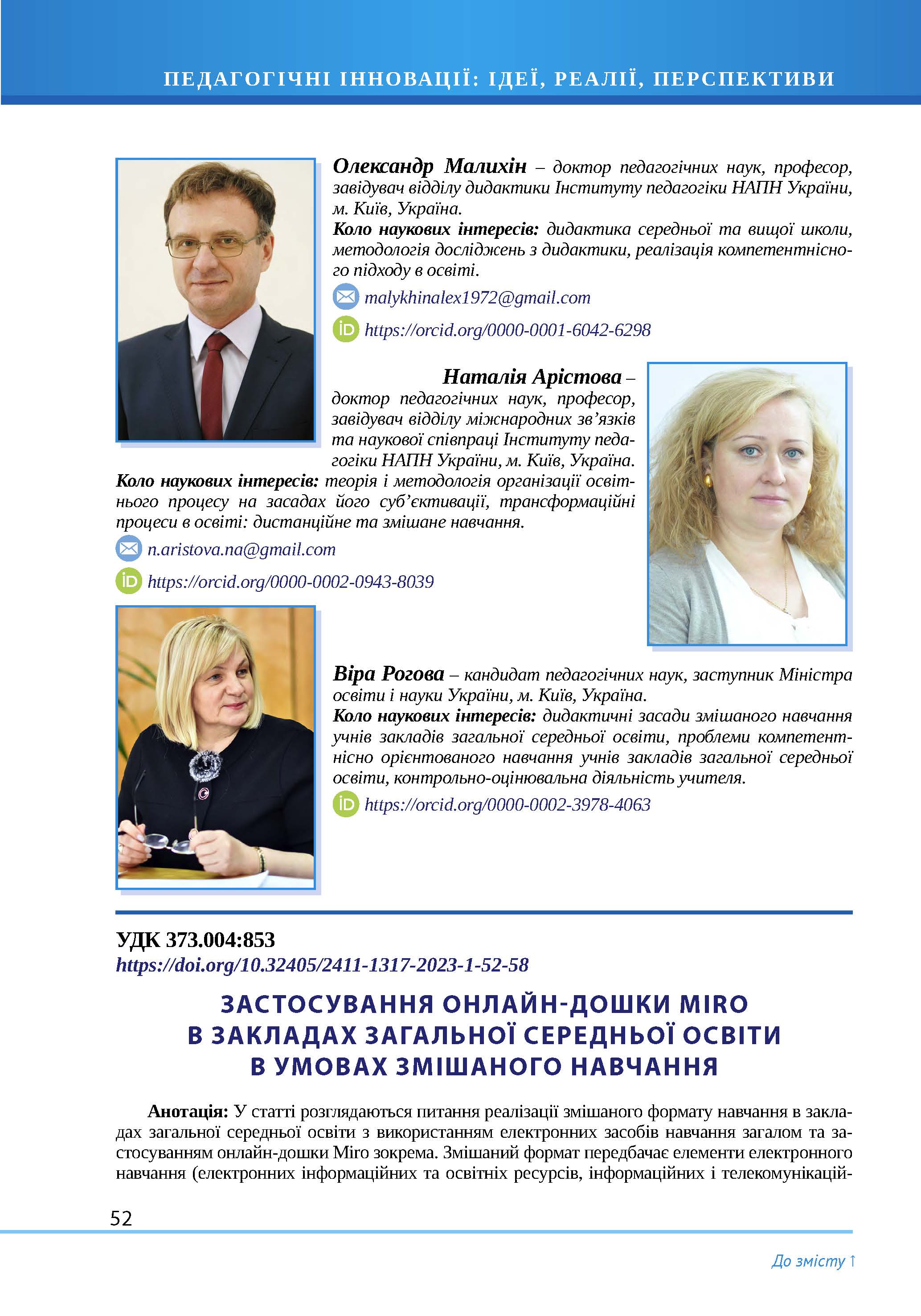Abstract
The article examines the implementation of blended learning in general secondary education institutions with electronic means of education in general and the use of the Miro online board in particular. The application of blended learning involves the use of elements of electronic learning (electronic information and educational resources, information and telecommunication technologies) while preserving the general principles of traditional educational process. At the same time, the combination of technologies can occur at the level of a separate topic, discipline, or at the level of the educational program as a whole.
Considerable attention is paid to the substantiation of the didactic potential of the Miro online board as a workspace with a number of educational functions. The advantages of using the Miro online board for providing blended learning in general secondary education institutions were analyzed and the possibilities of its usage for developing student-student interactions during group tasks were investigated.
It was concluded that the Miro online board contributes to the development of students' creative abilities while implementing problem-oriented and project-based learning. Joint types of work and interactive cooperation between students amid distance learning determine the effectiveness of knowledge acquisition, the development of various types of thinking and stimulate students’ cognitive activity. Virtual whiteboard services are an effective tool for organizing educational process in both synchronous and asynchronous learning formats. The Miro online board is regarded as a means of providing blended learning in general secondary education institutions which enables the effective organization of students-teacher’s interactive cooperation, the storage of gained results in the cloud environment which can be accessed at a convenient time via the appropriate link. The Miro online board enables to improve interactive cooperation between students, to provide feedback and to engage them in creative cooperation. Moreover, it promotes the development of students’ project-based activities and their ability to plan and analyze these activities. We see the prospect of further scientific research in the diversification of blended learning in general secondary education institutions by means of implementing information technologies.
References
Арістова, Н. O. (2021). Дидактичні засади індивідуалізації навчання в умовах змішаної форми організації освітнього процесу в закладах загальної середньої освіти: методологія дослідження. Анотовані результати науково-дослідної роботи Інституту педагогіки за 2021 рік. Київ: Педагогічна думка, 31–33.
Бугайчук, К. Л. (2016). Змішане навчання: теоретичний аналіз та стратегія впровадження в освітній процес вищих навчальних закладів. Інформаційні технології і засоби навчання, 54(4), 1–18.
Кузьменко, О., Лісова, Ю., & Новік К. (2022). Використання освітнього потенціалу онлайн-дошок в аспекті розвитку діалогічного мовлення учнів. Актуальнi питання гуманiтарних наук, 49(1), 270–279.
Кухаренко, В. М. (2015). Системний підхід до змішаного навчання. Інформаційні технології в освіті, 24, 53–67.
Малихін, О. В. (2010). Інформаційно-навчальне середовище як засіб ефективної організації самостійної навчальної діяльності студентів вищих педагогічних навчальних закладів. Наукові записки Тернопільського національного педагогічного університету. Серія: Педагогіка, 3, 33–38.
Малихін, О. В., Ковальчук, В. І., Арістова, Н. О., Попов, Р. А., & Гриценко, І. С. (2017). Стратегії інтенсифікації вищої гуманітарної освіти в Україні та країнах ЄС: монографія. Київ: НУБіП України.
Малихін, О., & Рогова, В. (2023). Сучасний підручник і його роль в умовах змішаного навчання. Проблеми сучасного підручника, 29, 117–124. https://doi.org/10.32405/2411-1309-2022-29-117-124.
Малихін, О., Арістова, Н., & Рогова, В. (2022). Мінімізація освітніх втрат учнів закладів загальної середньої освіти в умовах воєнного стану: Змішане навчання. Український педагогічний журнал, 3, 68–75. https://doi.org/10.32405/2411-1317-2022-3-68-76
Про затвердження Положення про дистанційне навчання (2013). Офіційний вебпортал парламенту України. https://zakon.rada.gov.ua/laws/show/z0703-13#Text
Топузов, О. М., Малихін, О. В., & Опалюк, Т. Л. (2018). Педагогічна майстерність: розвиток професійно-педагогічної адаптивності та соціальної рефлексії майбутнього вчителя. Київ: Педагогічна думка.
Bonk, C. J., Graham, C. R., Cross, J., & Moore, M. G. (2006). The Handbook of Blended Learning: Global Perspectives, Local Designs. Pfeiffer.
Majumdar, A. Blended Learning: Different combinations that work. (б. д.). Corporate Learning Management System and Custom eLearning Solutions | G-Cube. http://www.gc-solutions.net/blog/blended-learning-different-combinations-that-work/

This work is licensed under a Creative Commons Attribution-NonCommercial-ShareAlike 4.0 International License.


